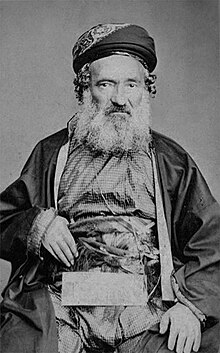| Jacob Saphir | |
|---|---|
| יעקב הלוי ספיר | |
 Jacob Saphir Jacob Saphir | |
| Born | 1822 Ashmyany, Russian Empire (now Belarus) |
| Died | 1886 Jerusalem, Ottoman Palestine |
| Nationality | Ottoman Palestine |
| Occupations |
|
| Known for |
|
| Notable work |
|
Jacob Saphir (Hebrew: יעקב הלוי ספיר; 1822–1886) was a 19th-century writer, ethnographer, researcher of Hebrew manuscripts, a traveler and emissary of the rabbis of Eastern European Jewish descent who settled in Jerusalem during his early life.
Background
Saphir was born in Ashmyany in the Russian Empire (now Belarus) and immigrated to Ottoman Palestine as a child with his family in 1832. His parents, who were from the Perushim community, settled in Safed. Within a year his father died and a month later his mother died. At the age of 12, he witnessed the attack by the Arabs of the Galilee on the Jews of Safed in the lunar month of Sivan, 1834. He moved to Jerusalem in 1836.
In 1848, he was commissioned by the Jewish community of the latter city to travel through the southern countries to collect alms for the poor of Jerusalem. In 1854 he undertook a second tour to collect funds for the construction of the Hurva Synagogue in the Jewish Quarter, which led him in 1859 to Yemen, British India, Egypt, and Australia.
The result of this journey was his momentous ethnographic work, entitled `Even Sapir, a travel diary and vignette of Jewish life and history in Yemen. Saphir published also Iggeret Teman (Wilna, 1868, consciously titled after Rambam's letter of centuries earlier), a work on the appearance in Yemen of the pseudo-Messiah Judah ben Shalom, and which was largely responsible for ending Judah ben Shalom's career. Saphir died in Jerusalem in 1886.
Saphir was the first Jewish researcher to recognize the significance of the Cairo geniza, as well as the first to publicize the existence of the Midrash ha-Gadol, both later studied with great panache by Solomon Schechter.
Sapir also did extensive research and writings on Yanover, Israeli and Greek etrogs. He dedicated a collection of poetry to Sir Moses and Lady Montefiore.
In the years 1833–1885, Saphir helped print the book Ḥemdat Yamim (reprinted Jerusalem 1977) by the arch-poet of Yemen, R. Shalom Shabazi, and even added an introduction to it.
See also
Jewish Encyclopedia bibliography
- Fuenn, Keneset Yisrael, pp. 557–558;
- idem, in Ha-Karmel, vi, Wilna, 1866;
- Geiger, Abraham, in Jüd. Zeit. xi.263-270.
References
- Jacob Saphir, Iben Safir (vol. 1 & 2) Lyck 1866 (Hebrew). Yaʻaḳov Sapir ha-Leṿi']; Second edition published in Mainz in 1874
- Hirschfeld, Hartwig; Montefiore Library. Jews' College. (1904). Descriptive catalogue of the Hebrew MSS. of the Montefiore Library. London:Macmillan. p. 121. Internet Archive website Retrieved 24 April 2018.
- [REDACTED] This article incorporates text from a publication now in the public domain: Singer, Isidore; et al., eds. (1901–1906). "SAPHIR, JACOB (known also as Eben Sappir)". The Jewish Encyclopedia. New York: Funk & Wagnalls.
External links
- Jewish Encyclopedia article on Jacob Saphir written by Isidore Singer & Schulim Ochser.
- Publications by Jacob Saphir
- Rabbi Jacob Levi Saphir & his Voyage to Australia
- 1822 births
- 1886 deaths
- Jews from Ottoman Palestine
- 19th-century rabbis from the Ottoman Empire
- Emigrants from the Russian Empire to the Ottoman Empire
- Burials at the Jewish cemetery on the Mount of Olives
- 19th-century male writers
- Lithuanian Jews
- Ashkenazi Jews from Ottoman Palestine
- 19th-century travel writers
- Jewish Yemeni history
- Yemen researchers
- Researchers of Yemenite Jewry
- People from Ashmyany
- Jewish anthropologists
- Jewish Indonesian history
- Shelichei derabonan (rabbis)